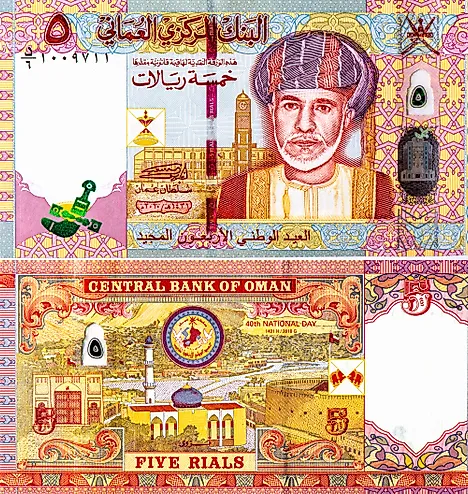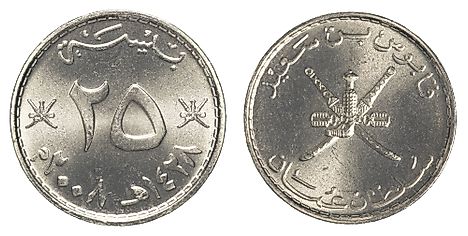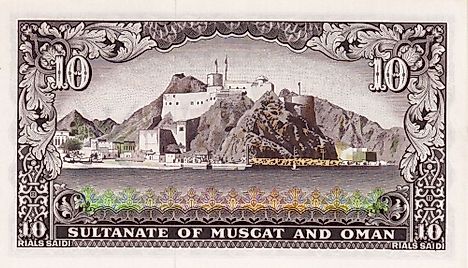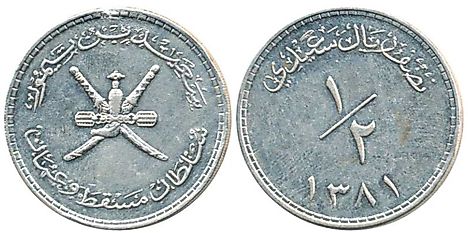Flags, Symbols, & Currencies of Oman
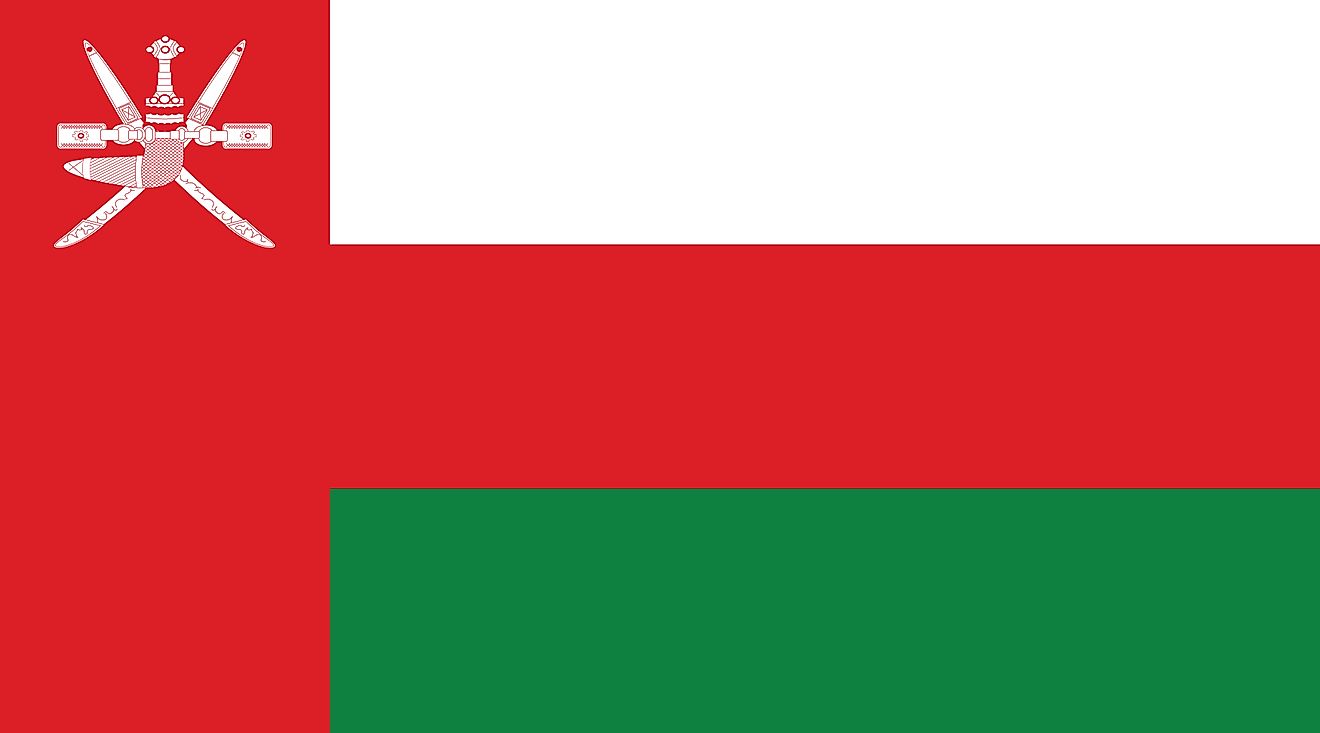
The flag of Oman was officially adopted on April 25, 1995. It resembles the old flag used between 1970 and 1995, except that the old flag had a thinner middle stripe. The flag has three horizontal stripes white (top), green, and red. A vertical red bar on the left of the flag features the country’s national emblem. The national flag has a height to length proportion of 1:2.
A lot of considerations went into the selection of the three colors for the flag of Oman. White, the color of the topmost horizontal band on the flag symbolizes peace and prosperity. The red color in the middle band and the vertical band of the flag represents the battles fought by the people of Oman against the foreign invaders. The green color represents the fertility of the land. The national emblem of the country depicts crossed swords over a dagger or khanjar.
Although the above meanings of the colors and symbols of the flag of Oman are officially accepted, the flag’s features have also been interpreted unofficially. According to such interpretations, white stands for the Imamate, red the Sultanate, and green is believed to represent the mountainous green interior of Oman.
The History Of The Flag Of Oman
In the past, the flag of Oman was a plain red banner. It was used by the indigenous people of the region. This banner was used as early as AD 750. For a short period of time, between 1868 and 1871, the symbol of the religious leader or imam of Oman, a plain white flag, served as the national flag of Oman. In 1970, the ruling Sultan of Oman was deposed and a new Sultan, Qābūs ibn Saʿīd, came to power. The new ruler wanted to modernize the nation. On December 17, 1970, the Sultan introduced a new national flag. On April 25, 1995, the national flag of Oman was officially adopted. It was a slight adaptation from 1970.
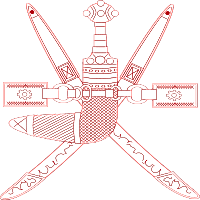
Oman's national emblem consists of a dagger (a Khanjar Dagger) and its sheath superimposed on two crossed swords in scabbards.
Symbols of Oman
National Coat of Arms of Oman

The national coat of arms of Oman is Khanjar Bo Sayfain. It consists of a dagger (a Khanjar Dagger) and its sheath superimposed on two crossed swords in scabbards. The national emblem features on the red vertical band of the national flag of Oman. It dates back to the 18th century and was mainly used by the Omani royal family.
National Anthem
- Anthem Title: "as-Salâm as-Solṭâni" ('Salute to The Sultan')
- Music Composer: Moħammed ʿAbdolwahâb and James Frederick Mills
- Lyricist: Ħafiẓ ben-Sâlem as-Sayl al-Gasâni
- Date of Adoption: 1970
"as-Salâm as-Solṭâni" is the national anthem of Oman. The music of the anthem have been composed by Moħammed ʿAbdolwahâb and James Frederick Mills. The lyrics of the anthem have been written by Ħafiẓ ben-Sâlem as-Sayl al-Gasâni. The anthem was officially adopted in 1970.
السلام السلطاني (Arabic)
يا ربنا احفظ لنا جلالة
السلطان
والشعب في الأوطان
بالعز و الأمان
وليدم مؤيدا ?
عاهلا ممجدا
? بالنفوس يفتدى
يا عمان نحن من عهد النبي
أوفياء من كرام العربي
فارتقي هام السماء
واملئي الكون الضياء
واسعدي وانعمي بالرخاء
Salute to The Sultan
O Almighty, save His Majesty the Sultan
and His people in their homelands
with pride and peace
? May He live long and triumphant
a glorified leader
for whom we shall lay down our lives ?
O Oman, we have been from the time of the
Prophet
of the most loyal and noble Arabs
So ascend to the apex of the heavens
illuminate the cosmos
rejoice and relish in prosperity.
The Currency of Oman is the Omani Rial
Oman is one of the three countries that use rial currency, with the other countries being Yemen and Iran. The Omani rial is subdivided into smaller units (1000) known as baisa. The Omani currency is issued in coins and banknotes form and is managed by the Central Bank of Oman. The rial was adopted in the early 1970s in place of the Indian rupee and as part of the modernization effort. The Omani rial is pegged to the United States dollar with the rate adjusted in 1986. The rial is the only legal tender unit in Oman with foreigners and visitors expected to convert their currencies to rial before they can make any purchase in the country.
Coins
In the 1890s coins of several denominations were minted for use in Muscat and Oman. In 1940, coins were minted in baisa denomination for use in Dhofar. In 1948, rial coins in the denomination of 0.5 were added to the biasa coins. In 1946, biasa coins in the denominations of 2, 5, and 20 were introduced in Oman, followed by rial coins in 1960. In 1970, common coins for both Muscat and Oman were introduced in biasa denominations ranging from 2 to 100 biasa. In 1975, new coins bearing the country’s name were issued. Currently, the coins in circulation include 5, 10, 25, 50, and 100 biasa.
Banknotes
Oman and Muscat issued the first banknotes in 1970 in biasa and rial Saidi denominations. In 1972, the Oman Currency Board issued 100 biasa and Omani rial coins in the denominations of ¼, ½, 1, 5, and 10. From 1977, the Central Bank of Oman has had the sole responsibility of issuing notes. Currently, the notes in circulation are in the denominations ranging from 100 biasa to 50 rials.
History of Currencies of Oman
Before 1940, Oman and Muscat used Indian Rupee and Maria Theresa Thaler as the official currency. The Rupee circulated mainly in the coast while the Thaler was used in the interior of Oman. The thaler was valued at 230 paisa with one rupee equaling 64 paisa. In 1940, coins were minted for use in the Dhofar and in 1946, coins were introduced in Oman. Both the coins introduced in 1940 and 1946 were in baisa denominations. The Indian Rupee and the Gulf Rupee continued to circulate alongside the coins. In 1970, Oman made rial Saidi its official currency, replacing the Gulf Rupee at an exchange rate of one rial for 21 rupees. The new currency was equal to the British pound and was subdivided into 1000 Baisa. Rial Saidi was replaced at par with the Omani rial in 1973.


